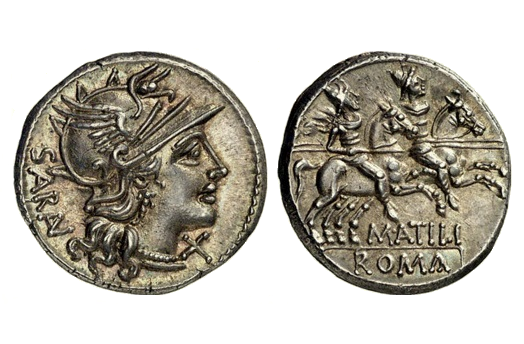
about ancient nomos
Ancient Nomos Art is a museum of galleries exhibiting ancient coins and ancient mint maps. The coin gallery displays the diverse art and history of hand-crafted ancient Greek, Roman, Byzantine, Persian and Medieval coinage. The ancient mints mapping gallery features Greek, Roman, Byzantine, Asia Minor and Medieval mint city regions and territories. Visitor's are welcome to explore, study and enjoy Ancient Nomos Art.

Roman Republic – 148 BC
Atilius Saranus
From Ancient Galleries

Obverse: Helmeted, winged head of Roma facing right with value "X" below chin.
Reverse: Dioscouri charging to right with spears in hand; ROMA in exergue below.
LEGEND
Obv: Helmeted head of Roma to right wearing winged helmet, earring, and pearl necklace; SARAN downward behind; X below chin. Rev: Two Dioscouri charging to right, wearing chalmys and holding spears; stars above each of their heads; M.ATILI below, ROMA in exergue within linear frame.
The earliest silver denarius coins of the Roman Republic can be indentified by their portrait of goddess Roma wearing a winged helmet. The depiction of Roma, wearing earrings and a pearl necklace, is intended to be the personification of Rome. The value mark X below chin indicates a denarius. The earliest Republican coins do not mention a moneyor by name, although occasionally the denarii featured control marks, symbols, letters, or monograms of the particular mint authority. Eventually, monograms and symbols were replaced with abbreviated forms of the moneyor’s name. The 148 BC Republican issued denarius is perhaps the earliest example depicting an individuals three part Latin name. In this case we know the individual was a patrician, Roman Senator and the coins moneyor (see special exhibit note below). The three part name (tria nomina) begins with the praenomen (given name, ie; M for Marcus), then nomen gentile or gentilicium (name of the gens or clan, ie; Atilius) and finally, cognomen (name of a family within the gens, ie; Saranus). The obverse legend on this coin is the cognomen and reverse legend the praenomen and nomen, all abbreviated. The Republican reverse usually depicts either a deity driving a biga or quadriga, or as in this case, a pair of dieties on horse back. The Dioscouri pair, or Sons of Zeus, are shown on the reverse charging to right, wearing chalmys with spears in hand. Dioskouroi, is a two part Greek word with “Dios” meaning Zeus and “Kouroi” meaning the Sons. The Romans referred to them as the twin sons of Jupiter (Zeus) and Leda, with Roman names Castor and Pollux. Zeus transformed them into stars now found in the constellation Gemini. This is why the Dioscuri are often shown wearing pointed caps with stars above them while riding horses. Legend says Castor and Pollux were thought to have assisted the Romans in defeating the Etruscans in 484 BC and appear together on many second century Republican coins.
SPECIAL EXHIBIT NOTE
Few sources confirm Saranus’ time in Rome when this denarius in his name was issued. However, one known later artifact does confirm the position, rank and senatorial status of Atilius M.f. Saranus. The artifact is one of the earliest extant ancient Roman Cippus stones inscribed in Latin. The Cippus stone was discovered in northern Italy. The stone engraved Latin inscription describes Atilius M.f. Saranus as Proconsul.
Here is the full transcribed Latin inscription found on the stone:
SEX. ATILIUS M. F. SARRANUS PROCOS / EX SENATI CONSULTO / INTER ATESTINOS ET VEICETINOS / FINIS TERMINOSQUE STATUI IUSIT
The Cippus artifact is an example of an ancient Republican Roman Senate decreed boundary border location stone. The stone was found in Lobia and is dated to circa 140-135 BC, presumably eight years after the above denarius issue date. The stone appears to state an official decree by the Senate in Rome to resolve a boundary border dispute between the cities of Vicetia and Ateste. The stone declares Atilius Saranus as Proconsul. Since Crawford believes this denarius was issued, circa 148 BC, it might be logical to assume Atilius Saranus was perhaps a high ranking Consul during the minting date of this coin. Apparently, Saranus became a Proconsul (usually the case after being Consul) and was likely charged with authority and jurisdiction overseeing the northern region of Italy. For more information, refer to the ANAM “Special Features” gallery link: Republican Roman Cippus Stone Latin Inscription
SPECIAL FEATURE EXHIBIT
The ANAM Special Features gallery takes a closer look at the uniquely small, exquisitely engraved and highly artful Republican Roman Horsemen and Chariot types, circa 1st, 2nd and 3rd centuries BC. To view the Special Features coin exhibit depicting this very important form of ancient equine transportation, please use the following link: Republican Roman Horsemen and Chariot Exhibit
DOCUMENTATION
Value: Denarius. Metal: AR Silver. Weight: 3.75 grams. Mint: Rome. Date: circa 148 BC.
Attribution: Atilia 9; Crawford 214/1b; Sydenham 398; Kestner 2015; BMCRR 679; LHS 100, 380.
Legend, Documentation and Attribution
